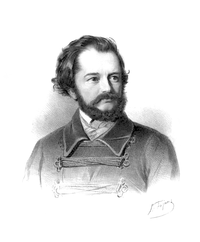It is always good to come across composers who we have never heard of before but whose music comes to life with vivid immediacy when the bow strokes the string. One such composer is Ignacy Dobrzyński (born in what was then Polish-Ukraine), a fellow classmate of Frédéric Chopin at the Warsaw Conservatoire.
Dobrzyński and Chopin were encouraged by their teacher Józef Elsner to incorporate polonaises, mazurkas and other traditional Polish folk music into their compositions. Their paths were ultimately very different. Chopin was at the forefront of the Romantic movement, his star ever rising. Dobrzyński, famous in his time, became rather lost in the foggy hinterland of less well known composers but his music deserves to be heard. We are pleased to be bringing his quartet in E minor op 7 to life.
Dobrzyński doesn’t step far out of the magnetic field of Joseph Haydn’s influence in his quartet.
Haydn’s op 50 no 5 is not one of his better known quartets but it is as supreme an example of quartet writing as any – succinct, unpredictable, fascinating. The dream-like slow movement holds its magical spell throughout its relatively brief appearance – a reverie in sound. What is the reverie about? Who knows?! This is surely one of the key elements of the very best art – that it offers our imagination opportunities to roam and dream without boundaries or foregone conclusions.
Shostakovich’s music stimulates the imagination too. What is the link between the 7th string quartet dedication – to his recently deceased wife – and the music within this work? (He was by all accounts deeply distressed by her death.)

Nina and Dmitri Shostakovich 1943 Photographed by A. Less © 2001 Cultural Heritage Series/Artistic Director Oksana Dvornichenko
As with so much of his music, we are left guessing to a large extent, and we are left with enigmas. One enigma in this work is announced very clearly and meaningfully by the viola near the beginning of the 3rd movement. After the violins and cello have launched into a cascade of violent semiquavers (described by some as a dog barking), the viola plays four quiet notes. They clearly mean something. But what? The notes can be analysed as forming a theme or part of a code but their presence in the context of the movement seems extremely telling, and yet we will never know for sure what the inner meaning is. We are simply drawn into a place where, in witnessing the enigma, we validate its potential to stimulate the imagination.
I feel a strong influence of the faster, turbulent section of Tchaikovsky’s Romeo and Juliet in this third movement. It is unbridled energy, fearless, fearsome. Perhaps the ending of the work wouldn’t be so effective without this sword-fight of a movement, which normally results in a few lost hairs in all respects. See you at the next series, when we’ll be wearing some pretty fetching wigs, no doubt.


Useful exposition of SQ7 in
https://en.wikipedia.org/wiki/String_Quartet_No._7_(Shostakovich)
A riddle wrapped in a mystery inside an enigma ?
Many layered, for sure. Pass the parcel.